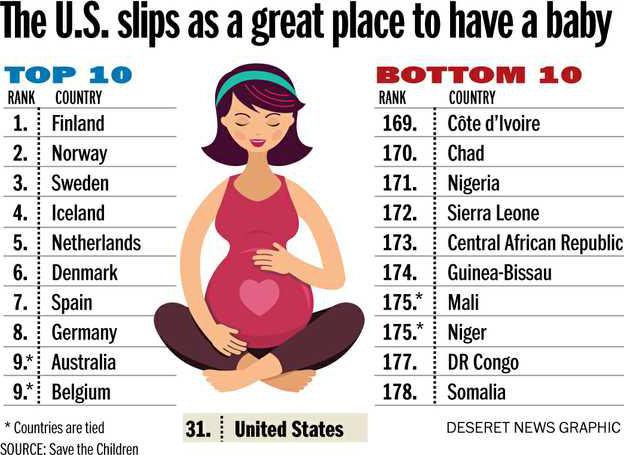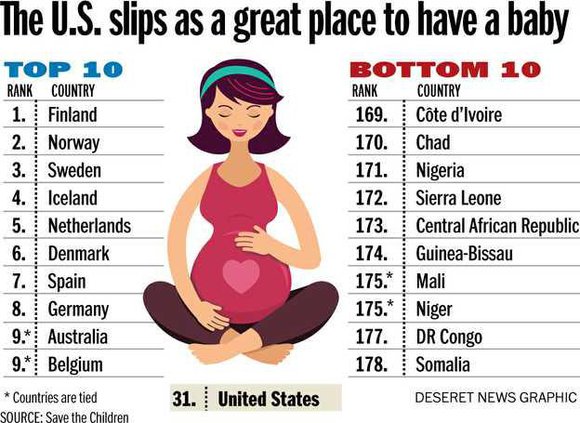![]() America is slipping as one of the best places to be a mother.
America is slipping as one of the best places to be a mother.
New reports on women and children show that the U.S. has increasing rates of death and trauma due to pregnancy and childbirth, especially compared to European countries.
Somalia is the most difficult country to be a mother, according to a report by Save the Children. Mothers there face a one-in-seven chance of death in childbirth, while women in Finland, which ranked No. 1, have odds of one-in-12,000. The United States falls behind many developed and developing countries, ranking on par with Iran and Romania.
The U.S. is among just eight countries in the world to increase in maternal mortality since 2003 — joining Afghanistan and African countries, according to another report from the University of Washington.
"The U.S. piece was surprising," said Carolyn Miles, CEO of Save the Children. "When we first started doing this study 15 years ago, the U.S. was No. 4, now it has moved to 31."
Leapfrogging and lacking
Some countries have made improvements in the last decade, said Miles, and have "leapfrogged" over the U.S., but the U.S. has also "failed to improve" in some areas.
One of those areas is risk factors: American women are having babies older, having more C-sections and are more likely to have complications due to obesity and diabetes, she says
The United States ranks third in the world for C-sections, where 30 percent of women have surgical deliveries, according to the World Health Organization. At least 10 percent of American C-sections were "unnecessary," according to the report.
Not all moms in the U.S. are getting equal treatment either, said Miles. In Scandinavia, where health care is universal and most everyone has access, moms fare very well. That's not the same in the United States.
"What is really striking in the U.S. is the inequality," said Miles. In the U.S. 18 mothers died for every 100,000 live births in 2013, which is double Saudi Arabia and Canada, where seven per 100,000 die. That number more than triples for black women in urban America, according to Miles.
"A black woman in New York has a worse mortality rate than a woman in Iraq," she said.
An ounce of prevention
Lack of access to prenatal care and complications from obesity and diabetes top the list of factors to blame for maternal mortality, according to the University of Washington study, but older mothers are not a main cause of the problem. The largest increase in deaths was in women aged 20 to 24.
So what could be causing young women to die in modern American hospitals? One possible factor, said Debra Bingham, vice president of research for the Association of Women’s Health, Obstetric and Neonatal Nurses (AWHONN), is the numbers can be skewed because it's only been in recent years that accurate numbers of maternal deaths have been reported.
"That's important, because if women don't matter enough to carefully count how many die giving birth that's a serious indicator," she said.
Aside from lack of access to care it's hard to pinpoint any one cause, but a rise in obesity and diabetes play a role. Obesity leads to higher risk of hypertension and C-section delivery because the birth canal can be obstructed, said Dr. Donna Harrison, and there's great chance for infection. "When bacteria gets in fat it multiplies more quickly," she said.
Debra Bingham is also concerned about trends to induce early delivery for "scheduling or convenience." AHWONN has launched a campaign called "Don't Rush Me, Let Me Go the Full Forty" to encourage women to complete a full 40 weeks of pregnancy before induction.
"While being done with pregnancy may seem tempting during those last few weeks, inducing labor is associated with increased risks including prematurity, cesarean surgery, hemorrhage and infection," said Bingham.
Pulmonary embolism and hemorrhaging — or uncontrolled bleeding — are two of the top causes of maternal mortality. After birth when the placenta separates, the uterus camps down to stanch the bleeding, but if the womb is tired, has become infected from long labor or suffers other complications the prevent shrinking, a woman can lose her entire blood volume in 10 minutes.
Early induction, hypertension, obesity and C-sections are all associated with higher risk of hemorrhage.
Looking out for mom
Some countries, like Afghanistan, have had great success with mother mortality rates through the use of trained midwives and birth attendants, and the same idea can be applied in the U.S., said Miles, by putting a focus on community healthcare in poor neighborhoods.
"Our health care systems really doesn't cater to the most disadvantaged people," said Miles. "It's a blanket system that gives many people access, but ignores high-risk populations."
The Affordable Care Act seeks to get coverage for more women and mandates that insurance covers 100 percent of prenatal care, maternity care and contraception. Save the Children's report ranks countries based on four criteria, and the U.S. ranks high in two of them — education and economic opportunity for women. It fares worse in infant and child mortality, and very poorly in women's representation in government.
The U.S. is ranked 96th in the world for women representation in government. Women make up 51 percent of the population in the U.S., but hold only 19 percent of the seats in Congress and the Senate. By comparison, in Finland and Sweden, women hold about 43 percent of parliamentary seats; in Rwanda they hold 58 percent.
"Women tend to make better health care policies that focus on women and children," said Miles. "That could really change things."
Email: laneanderson@deseretnews.com





